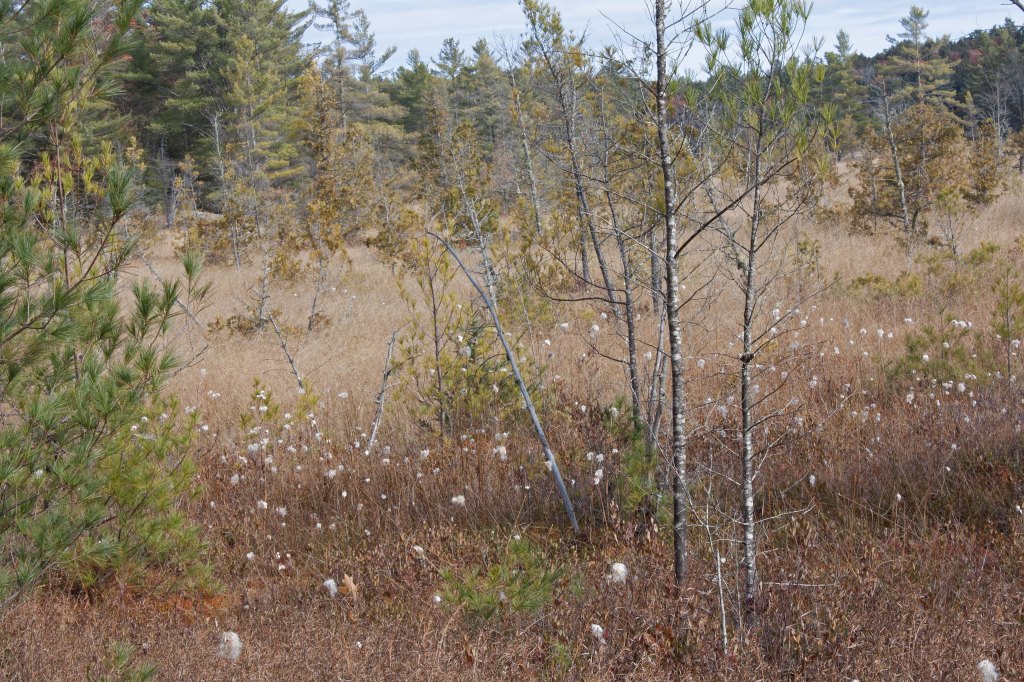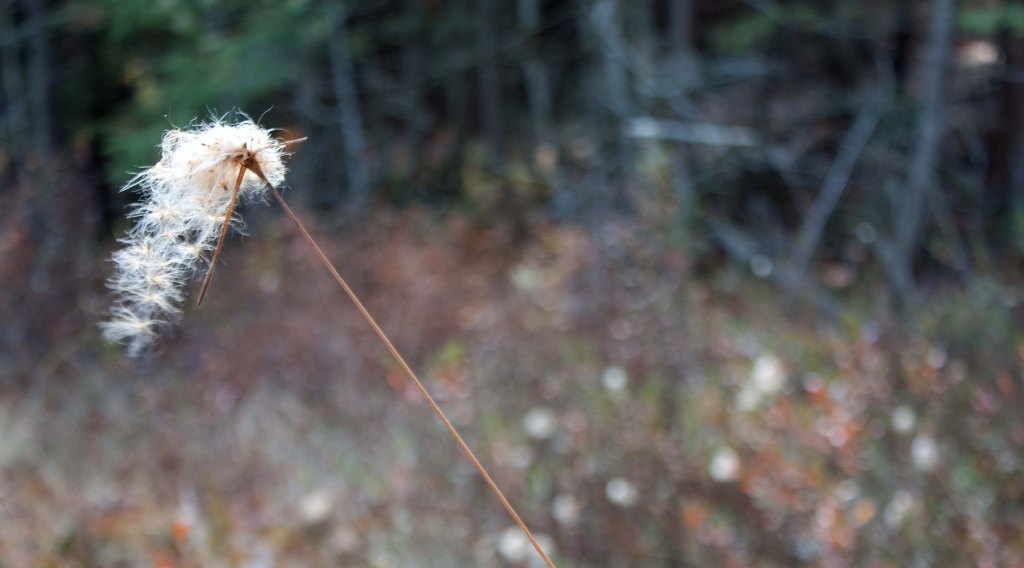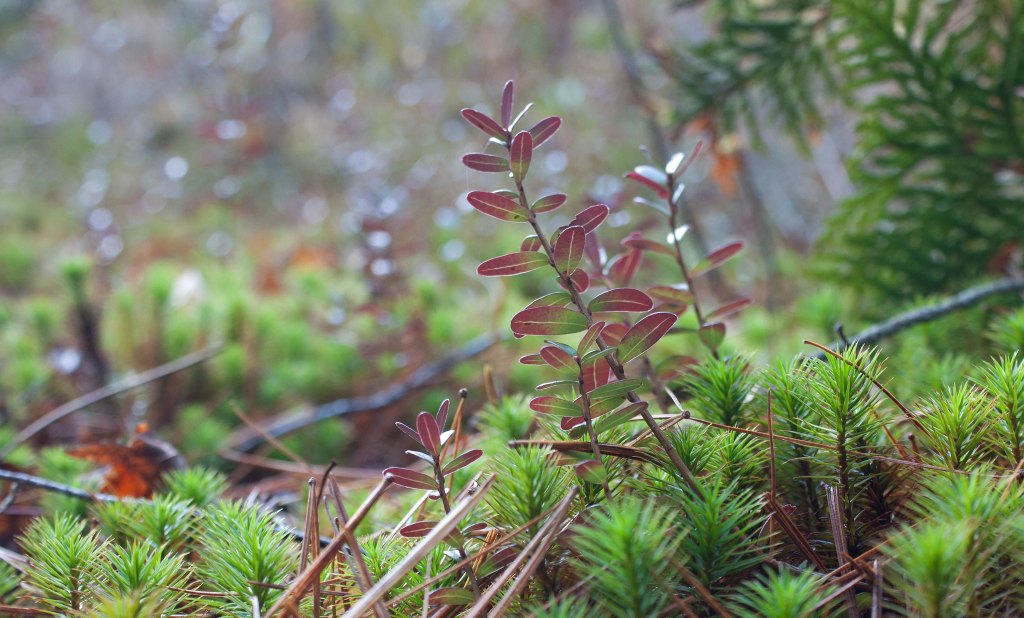During my walks through the hemlock old-growth forest of Catchacoma, I am always drawn to the golden light that shines through from the large open wetland just north of the trail.

On one November hike, I finally strayed off the trail and descended to the marsh. The sponge-like soggy surface gave in to my tentative steps as I negotiated my way down the uneven mounded terrain of old-growth forest. I still didn’t have quite the right footgear (just hiking boots), but I was able to get to the edge of the marsh and found my prize: Sphagnum!


.
Sphagnum moss covered a hummocky area that stretched out into the open marsh from the forest. Much of the wetland that I could see supported marsh grasses dotted with clumps of shrubs and coniferous trees—pine, hemlock, fir and others. The dark open waters with islands of hummocky sphagnum seemed to give way to open marsh grassland. I knew that it was riddled with open channels that lurked darkly beyond. I’d walked this sort of meadow marsh before; one moment I was walking on hummocky spungy ground, the next I’d plunged into dark deep waters.
.


.
.
The Mineral Meadow Marsh & Mineral Thicket Swamp of Catchacoma
Environmental consultants (Stantec, 2008) had earlier surveyed the >100 ha wetland and identified a number of mineral meadow marshes (where I was looking) and a mineral thicket swamp to the south—likely where I was currently standing—surrounded by extensive riparian vegetation (mostly pine and hemlock with a mix of yellow birch, spruce, fir, aspen, oak and maple).

.
I was standing on a mulchy hummock of Sphagnum amid waterlogged speckled alder (Alnus rugosa) and open pools of standing water. This area was characterized by shallow to deep channels of standing water and dead leaves that surrounded clusters of shrubs and Sphagnum mounds.
The Maine Department of Agriculture, Conservation & Forestry writes that speckled alder is most typical in these habitats with other trees such as red maple and birch scattered sparsely amid the shrubs. They described the herb layer as often well-developed (>35% cover), with a variable mixture of forbs, graminoids, and ferns. The bryoid layer they described consisted of patchy peat mosses, especially Sphagnum girgensohnii, S. palustre and S. magellanicum.
.

Sphagnum girgensohnii, also known as Girgensohn’s bogmoss or common green peat moss, grows in places of heavy shade, on moist forest soils and along margins of open water; pretty much where I was standing.
I peered beyond the shaded Alders into the open wetland, a matted herb layer of wetland species that included blue joint grass (Calamagrostis canadensis), marsh fern (Thelypteris palustris), fringed sedge (Carex crinita) and cattail (Typha sp.). Farther out, in the more open shallow marsh, other marsh plants included lake bank-sedge (Carex spp.) and fowl manna grass (Glyceria striata).
Later, on an autumn hike northwest of the alder swamp along the marsh-forest verge close to a granitic rocky outcrop, I spotted bog cottongrass (Eriophorum viridicarinatum) dotting the marsh meadow with fluffy balls of white like marshmallows floating in hot chocolate. The bog cottongrass is actually a perennial sedge native to Canada that lives in marshes, wet meadows, bogs, fens and wet woodlands.
.



.
Closer inspection of the sun-exposed spongy marsh from the rocky outcrop revealed a soft carpet of deep crimson and rich brown-gold–two types of Sphagnum moss (S. magellanicum and S. papillosum). Close to the granite outcrop I also discovered amid thick growths of Polytrichum moss a laced network of soft magenta Bog Cranberry (Vaccinium oxycoccos), blushing in the fall light.
.

.
.
Purple Pitcher Plant of Catchacoma

.
Just meters beyond where I was standing on the spongy edge of the wetland still under the forest canopy, I saw a large cluster of red-purple pitcher plants (Sarracenia purpurea), growing in the Sphagnum, grasses and low shrubs. They formed open, spreading rosettes of hollow gibbous leaves, mostly green, with glorious veins of purple-maroon. Some were bright red.
.
.
The purple pitcher plant (Sarracenia purpurea) is a carnivorous perennial forb that spreads by short rhizomes. They grow in nutrient-poor fens, seepage swamps, Sphagnum bogs and pine savannas throughout Canada. Sarracenia purpurea is the only pitcher plant species in Canada. It gets its food by trapping and digesting flying and crawling insects, making it one of the few carnivorous plants in North America. All pitcher plants use a pitfall trap to catch insects and other small animals.
.
.
Makoto Honda tells us that the name comes from their hollow trap leaves which are shaped like a pitcher. These modified leaves serve as reservoirs to collect rainwater into which the plant secretes its own liquid, as well as hydrolases and other proteins for prey digestion. Makoto adds that “people in the eighteenth century believed that the pitchers [were] intended to provide a merciful refuge for poor insects fleeing from their predators. On the contrary, we now know that the hollow pitcher leaves are carefully constructed and deceptively clever traps of these meat-eating plants.”
.
.
Drawn to Sarracenia purpurea’s nectar, foraging insects land on the broad slippery lips or ‘hood’ (peristome) of the leaf and lose their footing, tumbling, sliding or foolishly crawling down the waxy zone (slippery zone) of the pitcher tube where stiff downward pointing hairs prevent them from escaping. Flies, ants, spiders, and even moths and hornets drown in the rain water collected at the base of the pitcher (the ‘trap’), where digestive enzymes (hydrolases and proteases) secreted by the plant release the nutrients for the plant to utilize. Even juvenile salamanders and frogs are known to fall into the pitcher and drown. Organisms unaffected by the pitcher plant’s toxic aquatic environment, such as mosquito larvae and midges, also digest prey, living in a commensal relationship with the plant. Protista, rotifers and bacteria that live in the pitcher’s liquid also help process drowned prey, shredding and mineralizing them into available nutrients for the plant. It’s one compelling carnivorous community!
Rosa et al. (2009) suggest that carnivory in pitcher plants evolved primarily for nitrogen acquisition, given that they typically grow in nitrogen-poor peat bogs, and stop being carnivores in nitrogen-rich environments.
.

.
Sarracenia purpurea is currently endangered—mostly from habitat destruction. The wetland habitat preferred by the purple pitcher plant is threatened in Ontario by draining, logging, and woody encroachment due to fire suppression. In 2020, NatureServe confirmed it as Globally Vulnerable.
The Bancroft-Minden Forest Company plans to log a large part of this unique 662 hectare old-growth hemlock forest right to the edge of this wetland. Not only is this a violation of the federal Fisheries Act and the provincial Forest Practices Code, but it promises to disrupt this sensitive wetland and may even eradicate the purple pitcher plant.
.
.
.
Sphagnums of Catchacoma

.
I walked carefully along the hummocky area along the riparian edge, among speckled alder trees, birch, and marsh shrubs. One hummock was covered by mostly large stunning red-tinged Sphagnum moss with short fat branches and hooded branch leaves that I later identified as Sphagnum magellanicum (also known as Magellanic bogmoss or Magellan’s sphagnum).
.
.
Jerry Jenkins writes that Sphagnum magellanicum is a very common moss species, found in all sorts of wetlands. It’s known to grow in ombrotrophic to rich fens and open or forested bogs and swamps, forming expansive carpets, low hummocks, and often mixed with other Sphagnum species—which I observed. The other Sphagnum species that grew with S. magellanicum I identified as Sphagnum palustre, another common Sphagnum of wet woods, swamps, and marshes, known to often grow with S. magellanicum in organic Alder thicket swamps. These plants also had reddish centres but showed very different leaf structure and arrangement. According to the British Bryological Society, S. palustre can develop a brick-red capitulum centre, but is distinctly arched above and contrasts with the paler, spreading, outer branches, which are usually elongated and tapering.
.




.
.
Sphagnum Ecology (from Weston et al)
Weston et al. (2017) tell us that Sphagnum has a “remarkable ability to create and then uniquely thrive in nutrient-poor, acidic, and waterlogged conditions.” The suite of morphological, physiological, and life history traits that affect Sphagnum fitness—functional traits—enable this ‘ecosystem engineer’ to gain a competitive advantage over other co- occurring species and flourish under relatively harsh environmental conditions. “The ability of Sphagnum to store and transport water is controlled largely by three distinct morphological adaptations – branching architecture, leaf size and arrangement on branches, and hyaline cells.”
.

.
“Hummock-forming species have small close-set leaves forming numerous interconnected small capillary spaces. Spreading branches allow lateral movement of water through the capillary continuum, while numerous close-set pendant branches appressed to the stem form an efficient vertical water-transport system. Sphagnum species growing on hummocks can wick moisture and maintain metabolic activity even during drought. In all species, dead hyaline cells in the leaves and the outer cortex of the stems and branches act as water-storage structures.”
.
.
The top of Sphagnum stems are alive, but a few centimeters down the cells are dead and permeable to water and gases. Loss of stem strength and increasing weight eventually results in collapse of the plant structure, reducing the pore size so water can no longer flow easily through it; at this point downwards the peat is permanently waterlogged and this is what determines the depth of the water table. In the waterlogged zone, oxygen is used up.
“Through distinct traits, Sphagnum generates environmental conditions that are suitable for its own growth but hostile for the vast majority of other plants.”
Weston et al., 2017
It’s not fully understood how Sphagnum inhibits fungal and microbial decomposition to promote peat accumulation. What’s known is that it involves both the external environment engineered by the species, as well as the internal biochemistry of its plant tissue, particularly—according to Weston et al.—the low nitrogen to carbon ratio (a reflection of the unusually efficient use of nitrogen in producing new biomass).
.

.
Peatland ecologists have shown that individual Sphagnum species demonstrate narrow niches along a hydrological gradient—from low hollow to high hummock (Vitt & Slack, 1984). Sphagnum species also show narrow preferences along a chemical gradient, with some species preferring acidic ombrotrophic bogs and other species preferring fens with more neutral pH. The Sphagnum species I’ve encountered on the wetland verges of the Catchacoma forest demonstrate a wider niche for both moisture and pH.
Drawing on the work of Couillard and Grondin (1986), Bastien and Garneau (1997) describe the two as follows: a peatland nourished by ground water that has been in contact with mineral soil is minerotrophic and is called a “fen”; when the peatland is nourished primarily by rainwater and the peat is built up to the point where surface vegetation is above the water table, the peatland is ombrotrophic and is called a “bog.”
The wetlands of Catchacoma show a continuum, with traits of both types of peatlands (and associated Sphagnum communities), from mineral swamp-forest to open grassland marsh.
.

.
.
References:
Bastien, D-F and M. Garneau. 1997. “Macroscopic Identification Key of 36 Sphagnum Species in Eastern Canada.” Geological Survey of Canada Miscellaneous Report 61. 41pp.
Couillard, L. et P. Grondin.1986: La végétation des milieux humides du Québec. Les publications du Québec. Gouvernement du Québec, Québec. 399 pp.
Flora of North America. 2020. “Sphagnum magellanicum.”
Haavisto, V.F. 1974. “Sphagnum Mosses of Ontario: Identification by Macroscopic Features.” Great Lakes Forest Research Centre Information Report 0-X-216. December. 36pp.
Jenkins, Jerry. 2020. “Mosses of the Northern Forest: A Photographic Guide.” Cornell University Press, Ithaca. 169pp.
Maine Department of Agriculture, Conservation & Forestry. 2021. “Alder Thicket”.
Rosa, Bruce A., Lada Malek and Wensheng Qin. 2009. “The development of the pitcher plant Sarracenia purpurea into a potentially valuable recombinant protein production system.” biotechnology and Molecular Biology Reviews 3(5): 105-110.
Stantec (Stantec Consulting Ltd.). 2008. “Kawartha Highlands Signature Site Park Access Road Study: Final Environmental Study Report.” Prepared for Ontario Parks, Ministry of Natural Resources, Peterborough, Ontario.
Quigly, Peter. 2020. “The Catchacoma Ancient Forest Landscape: An Initial Inventory of Species and Habitats.” Ancient Forest Exploration & Research, Research Report No. 39. 15pp.
Vitt, Dale H. and Nancy G. Slack. 1984. “Niche diversification of Sphagnum relative to environmental factors in northern Minnesota peatlands.” Can J. Botany 62: 1409-1430.
Weston, et. al. 2017. “The Sphagnome Project: enabling ecological and evolutionary insights through a genus-level sequencing project.” New Phytologist, October.
.

.

Nina Munteanu is a Canadian ecologist / limnologist and novelist. She is co-editor of Europa SF and currently teaches writing courses at George Brown College and the University of Toronto. Visit www.ninamunteanu.ca for the latest on her books. Nina’s bilingual “La natura dell’acqua / The Way of Water” was published by Mincione Edizioni in Rome. Her non-fiction book “Water Is…” by Pixl Press (Vancouver) was selected by Margaret Atwood in the New York Times ‘Year in Reading’ and was chosen as the 2017 Summer Read by Water Canada. Her novel “A Diary in the Age of Water” was released by Inanna Publications (Toronto) in June 2020.








4 thoughts on “The Wetlands of Catchacoma Forest: Hidden Treasures of Sphagnum Moss and Carnivorous Plants”